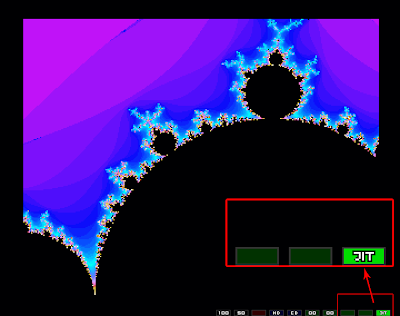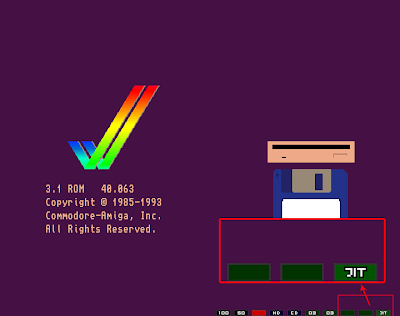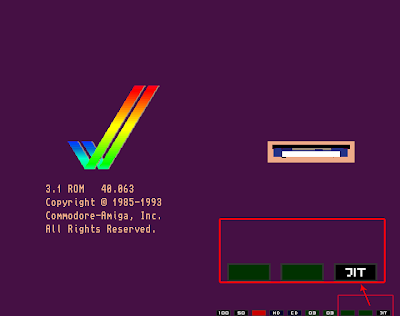Watch for the LED
Since there were too many complaints (too many > 2) about that it is hard to tell whether the JIT compiled code is active or not, I decided to implement a small on-screen indicator for it in this tiny update.
How does it work?
I extended the already available on-screen status line with one more "LED" which says: JIT.
If you turn on the OSD status line by adding the following lines into the configuration:
show_leds=true
Then you will find one more block at the end of the status line. This "LED" will lit up in bright greenish color as soon as the emulator executes JIT compiled code (instead of interpreted code).
Now, since the emulation is (and always will be) a mixture of JIT compiled and interpreted execution, it is not a simple task to find out how much of the executed code was JIT compiled and how much is interpreted.
To overcome of this complication the block will show you the ratio between the compiled and the interpreted code by changing the background color:
- If more compiled code was executed then it is more vivid light green.
- If the interpreted code dominated the execution then the color dims toward black.
- When the JIT is inactive (turned off by the configuration) or for any reason the compiled code is not used (cache turned off, blocks are too short, etc.) then the background color will be completely black.
Here you can see some example screenshots:
 |
| The indicator lits up light green: JIT compiled code is running mostly. |
 |
| The indicator is still green, but more dark green: a mixture of JIT compiled code and interpreted code is executed. The darker means less JIT code. |
 |
| The indicator is black: JIT is turned off or the compiled code is not executed for some reason. |
So, now you can tell by simply looking at the screen if the JIT is active and how much of the executed code makes use of the JIT compiling.
Tiny-tiny catch
I didn't want to add extensive statistical data collection into the compiled code, it would make it run a lot slower.
This implementation slows down the emulation a tiny bit, but not that much. Probably later on I will either remove it completely or add some configuration around it, so it could be turned off.
How does it really work?
To tell you the truth: the indicator doesn't show you exactly how much of the actual instructions are executed by the JIT or the interpretive, but it collects the data from executed code block types. This is cheating beacuse:
- The length of the blocks vary between 1 instruction and 20-30 (or sometimes even more) instructions. Still one block counts exactly once in the calculation, regardless of the size.
This could be improved, but I didn't want to put too much effort into this implementation. - Even inside the compiled blocks not all of the instructions are JIT compiled (as I described this in earlier posts). Thus it is possible that none of the instructions in the "compiled" block consist of actual JIT code, but simply calls to the interpretive implementation. It would be more fair to calculate the ration based on the executed instruction types instead of the block types.
Now, I would rather not change this for sake of performance. As long as most of the instructions are implemented, this won't affect the results too much. (And that is not true just yet, but will be improved overtime.)
So, bottom line: take this indicator results with a grain of salt.
Still cool, eh? :)